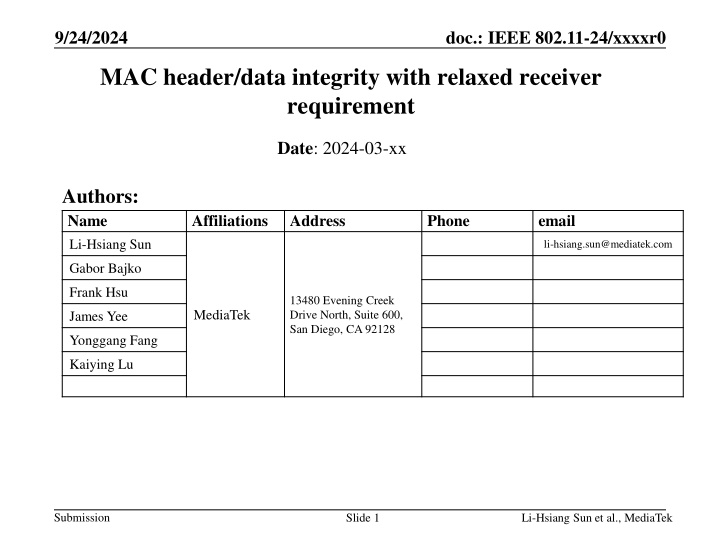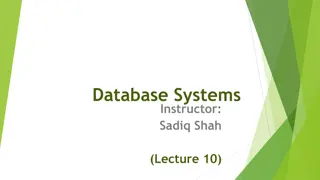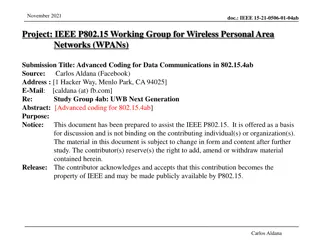Enhancing Data Integrity in IEEE 802.11 Networks
This document discusses proposals for improving data integrity in IEEE 802.11 networks, specifically focusing on header protection for individually addressed data and management frames. It explores the challenges and alternatives related to verifying Message Integrity Check (MIC) before sending acknowledgments, addressing potential replay attacks, and proposing scenarios for ensuring a high level of protection against data manipulation. The content emphasizes the importance of maintaining data integrity in wireless communication protocols.
Download Presentation

Please find below an Image/Link to download the presentation.
The content on the website is provided AS IS for your information and personal use only. It may not be sold, licensed, or shared on other websites without obtaining consent from the author.If you encounter any issues during the download, it is possible that the publisher has removed the file from their server.
You are allowed to download the files provided on this website for personal or commercial use, subject to the condition that they are used lawfully. All files are the property of their respective owners.
The content on the website is provided AS IS for your information and personal use only. It may not be sold, licensed, or shared on other websites without obtaining consent from the author.
E N D
Presentation Transcript
9/24/2024 doc.: IEEE 802.11-24/xxxxr0 MAC header/data integrity with relaxed receiver requirement Date: 2024-03-xx Authors: Name Li-Hsiang Sun Affiliations Address Phone email li-hsiang.sun@mediatek.com Gabor Bajko Frank Hsu 13480 Evening Creek Drive North, Suite 600, San Diego, CA 92128 MediaTek James Yee Yonggang Fang Kaiying Lu Submission Slide 1 Li-Hsiang Sun et al., MediaTek
9/24/2024 doc.: IEEE 802.11-24/xxxxr0 Background [1] proposed header protection for individually addressed Data and Management frames A new MIC is generated for the header fields each time an MPDU is (re)transmitted It is generally assumed that the recipient of unicast data/management frames would verify header MIC before sending Ack/BA Considerations at receiver side for MIC verification before BA/Ack: Recipient may have processing/cost constraints/performance degradation for processing all the MICs received in a high rate AMPDU before sending immediate ack/BA Extra padding/delimiters in an AMPDU reduces throughput Header MIC check does not guarantee the data integrity [2] illustrates an issue of a jam/record/replay attack proposed to use portion of the TSF as PN in the header MIC Verifying MIC and TSF before sending ACK comes at an even higher cost to receiver Slide 2 Submission , MediaTek
9/24/2024 doc.: IEEE 802.11-24/xxxxr0 Alternatives to MIC check before sending ack Recipient would not need to check the MIC before sending protected ACK Originator would check that the ACK is genuine and solicited before removing PPDUs from the retransmit buffer and confirming the MAC state change Originator would verify the MIC of the Ack Even if the Ack is unsolicited Preform replay check. Update of replay counter if Ack is fresh Discard the Ack if unsolicited To prevent the ack being replayed by an attacker at a later time, a TSF protected Ack may be needed Transmitter would check the ACK with TSF and MIC before accepting the ACK Including a TSF into the MIC of the ACK is FFS Consequences of an attack at both side are still prevented. Submission Slide 3 , MediaTek
9/24/2024 doc.: IEEE 802.11-24/xxxxr0 The below 2 scenarios provide same level of protection Check H_MIC before sending ACK Check D_MIC after sending ACK B A Data frame [H_MIC, D_MIC] Check MIC before taking any action Protected ack [MIC] Only FCS check before sending ACK A B Check both H_MIC and D_MIC after sending ACK Data frame [H_MIC, D_MIC] Check MIC before taking any action Protected ack [MIC] Check both H_MIC and D_MIC before sending ACK BAR Protected ack Submission Slide 4 , MediaTek
9/24/2024 doc.: IEEE 802.11-24/xxxxr0 I. Attack scenarios which can be prevented without TSF in the PN: Attacker modifies data frame, does not replay ACK Recipient protects the ack instead of checking the header MIC of the soliciting frame before Ack Submission Slide 5 , MediaTek
9/24/2024 doc.: IEEE 802.11-24/xxxxr0 scenario I.1 MITM sends modified MPDUs without header change Instead of being detected by time-based header MIC check at recipient side, originator can detect because of unsolicited ack A MITM B SN=1,2,3,4 Expecting solicited ack Modified data SN=1,2 Protected ack SN=1,2 A verifies the protected ack, updates replay counter for the ctrl frame protection (if not replay) A then drops the ack b/c it s unsolicited Submission Slide 6 , MediaTek
9/24/2024 doc.: IEEE 802.11-24/xxxxr0 scenario I.1 extension A verifies the protected ack, updates replay counter for the ctrl frame protection (if not replay) A then drops the ack b/c it s unsolicited MITM sends modified MPDUs with both data and header change for SN=1,2 B sends first protected ack for SN=1,2,3,4 after FCS check only A detects an unsolicited ack and does not update its tx buffer/MAC states B verifies header and body MICs of SN=1,2,3,4, only SN=3,4 pass After detecting attack, A sends a protected standalone protected BAR to check the receiver status B sends protected ack for SN=3,4 A verifies the ack and removes SN=3,4 from TX buffer A MITM B SN=1,2,3,4 SN=1,2,3,4, modified data and header for SN=1,2 Expecting solicited ack Protected ack SN=1,2,3,4 BAR Protected ack for SN=3,4 Submission Slide 7 , MediaTek
9/24/2024 doc.: IEEE 802.11-24/xxxxr0 scenario I.2 A MITM B MITM sends fakes data Instead of being detected by header MIC check at recipient side, it can be detected by originator because of unsolicited ack Fake SN=1,2 Protected ack SN=1,2 A verifies the protected ack, updates replay counter for the ctrl frame protection (if not replay) A then drops the ack b/c it s unsolicited Submission Slide 8 , MediaTek
9/24/2024 doc.: IEEE 802.11-24/xxxxr0 Verifying header MIC before ack as per [2] B checks FCS B verifies header MIC B verifies TSF in header close to the current TSF Check only FCS before ack as proposed in this doc B checks FCS B sends protected Ack (w or w/o TSF) A verifies the MIC of the ack and its freshness, performs replay check of the Ack A removes ack ed MSDU from TX buffer, updates MAC states B verifies header and body MICs* and checks replay of both, B updates MAC states, performs duplicate detection, update scoreboard, B buffers and re-orders B updates MAC states, performs duplicate detection, updates scoreboard B sends protected ack A verifies the MIC of the ack, performs replay check of the Ack A removes ack ed MSDU from TX buffer, updates MAC states B verifies body MIC*, buffers, re-orders, and checks replay *both mechanisms cannot handle the MIC check failure after ack Submission Slide 9 , MediaTek
9/24/2024 doc.: IEEE 802.11-24/xxxxr0 Conclusion For the scenarios in which the Ack is not replayed by attacker, checking the header MIC at the receiver side before sending the ACK does not provide additional protection vs the case when the header MIC is checked at the receiver side after sending protected ACK Assuming the protected ACK is verified at the sender side before updating its TX buffer, MAC layer states Shifting the freshness-checking burden to the originator side, which is simpler to implement Originator does not have a SIFS deadline of MIC processing. The MIC check, and the follow-up actions can happen in parallel with the transmission of other MPDUs in the TXOP Originator only verifies a single response frame from each recipient Recipient does not need to have a SIFS deadline for TSF protected header MIC checking. Recipient checks header/data MIC after sending ack. It won t change state/act based on the MPDUs yet be verified. Submission Slide 10 , MediaTek
9/24/2024 doc.: IEEE 802.11-24/xxxxr0 II. Attack scenarios which can only be protected with TSF in the PN II.1 Attacker modifies the data frame and jams sender to prevent it from receiving the ACK II.2 Attacker injects data frame to replay ACK later III.3 Attacker jams sender to prevent it from receiving ACK, then jams recipient to prevent it from receiving the resent data with modified header and replays ACK Submission Slide 11 , MediaTek
9/24/2024 doc.: IEEE 802.11-24/xxxxr0 The below 2 scenarios provide same level of protection for scenarios II.1 and II.2 Only TSF in ACK (lower figure) can protect against scenario II.3 Check H_MICand TSF before sending ACK Check D_MIC after sending ACK B A Data frame [H_MIC, TSF, D_MIC] Check MIC before taking any action Protected ack [MIC] Only FCS check before sending ACK A B Check both H_MIC and D_MIC after sending ACK Data frame [H_MIC, no TSF, D_MIC] Check MIC and TSF before taking any action Protected ack [MIC, TSF] Check both H_MIC and D_MIC before sending ACK BAR Protected ack Submission Slide 12 , MediaTek
9/24/2024 doc.: IEEE 802.11-24/xxxxr0 scenario II.1 A MITM B MITM sends modified MPDUs with both data and header change Instead of being detected by time- based header MIC check at recipient side, it can be detected by time-based protected ack SN=1,2,3,4, PM=1 Expecting solicited ack Modified SN=1,2, PM=0 Protected ack SN=1,2 BAR, PM=1 Replayed Protected ack SN=1,2 A verifies the protected ack, updates replay counter for the ctrl frame protection (if not replay) A then drops the ack b/c time-based protected ack not fresh Submission , MediaTek Slide 13
9/24/2024 doc.: IEEE 802.11-24/xxxxr0 scenario II.2 MITM sends fakes data MITM buffers and replays protected ack A MITM B Fake SN=1,2 Instead of being detected by header MIC check at recipient side, it can be detected by time-based protected ack at originator side Protected ack SN=1,2 Genuine SN=1,2,3,4 Replayed Protected ack SN=1,2 A verifies the protected ack, updates replay counter for the ctrl frame protection (if not replay) A then drops the ack b/c time-based protected ack not fresh Submission Slide 14 , MediaTek
9/24/2024 doc.: IEEE 802.11-24/xxxxr0 scenario II.3 (can only be protected if TSF is in ACK) A MITM B A reTX data with a newer header, then MITM relays the ack Cannot be detected by header MIC check at recipient side, but it can be detected at originator side by time-based protected ack at originator side Genuine SN=1,2, PM=0 (same as previous pkts) Protected ack SN=1,2 Expecting solicited ack Genuine SN=1,2, PM=1 (change) Replayed Protected ack SN=1,2 A verifies the protected ack, updates replay counter for the ctrl frame protection (if not replay) A then drops the ack b/c time-based protected ack MIC check not fresh Submission Slide 15 , MediaTek
9/24/2024 doc.: IEEE 802.11-24/xxxxr0 Preventing attack scenarios II Feasibility of using TSF for Ack protection needs to be evaluated Need to resolve several additional issues before we can make use of TSF: TSF is currently not protected in Beacon Even if TSF would be protected in Beacon It was protected by a group key which is less secure, but it is used later in unicast frame exchange Protected beacon itself can be replayed causing STA to be unsynchronized with AP Adding TSF protection in TGbn timeframe may be difficult, instead, we may a) Only handle attacks in type I scenarios (cases in which originator receives the ack), or b) Instead of making use of TSF, handle attacks in type I and II scenarios by introducing some linkage between soliciting frame and ack to ensure the timeliness of the ack See next slide Slide 16 Submission , MediaTek
9/24/2024 doc.: IEEE 802.11-24/xxxxr0 linkage between soliciting frame and ack Inputs to Ack/BA MIC may include additional data which contains info of the soliciting PPDU e.g. some bits in soliciting MPDUs, with bit locations known by originator and recipient Difficult for attacker to selectively replace some bits while not changing others e.g. header MIC, # of symbols between the MIC and the ack Difficult for attacker to send unpredictable bits (header MIC) and altered bits (altered header fields) in the same symbol at the correct time e.g. soliciting PPDU length and one or more of the corrected received header MIC Some bits from soliciting PPDU as input of Ack MIC SIFS MPDU4 MPDU1 MPDU3 preamble MPDU2 x MIC ACK Submission Slide 17 , MediaTek
9/24/2024 doc.: IEEE 802.11-24/xxxxr0 Reference [1] 11-23/1888r1 MAC header protection follow-up [2] 11-23/1960 Enhanced replay detection for header protection Submission Slide 18 , MediaTek
9/24/2024 doc.: IEEE 802.11-24/xxxxr0 SP1 Do you agree to define a mode that a recipient only checks the FCS of the soliciting individually addressed data and management frame with MAC header protection before sending protected immediate acknowledgement, and the sender checks the MIC in the acknowledgement? Submission Slide 19 , MediaTek
9/24/2024 doc.: IEEE 802.11-24/xxxxr0 SP2 Do you agree that if a recipient only checks the FCS of the soliciting individually addressed data and management frame with MAC header protection before sending immediate acknowledgement, then the recipient shall check the PN and MIC of the MAC header protection while processing the solicited frame after sending the acknowledgement? Submission Slide 20 , MediaTek






















